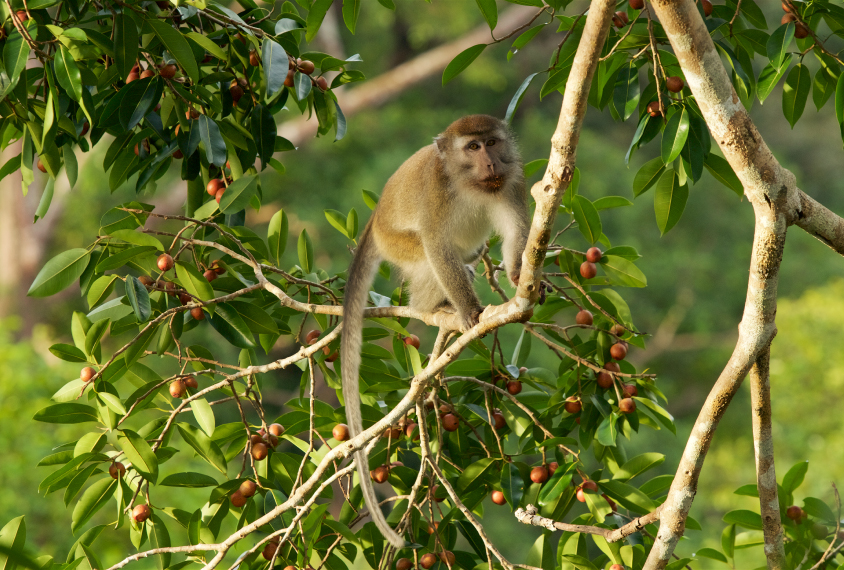A drug injected into the spinal canal of monkeys activates expression of the paternal copy of UBE3A — a gene linked to Angelman syndrome — in their brain, raising hopes for the success of a human clinical trial currently underway.
Angelman syndrome is a debilitating condition marked by seizures, intellectual disability, deficits in communication and coordination, and sometimes autism. The syndrome arises primarily from an absence of E3A ubiquitin-protein ligase (UBE3A) in a child’s brain. People typically inherit working copies of the UBE3A gene from both parents but develop Angelman if the maternal copy is missing or contains mutations.
That’s because a process called imprinting usually silences the paternal copy. Researchers have long sought a way to restore UBE3A levels by unsilencing it — a strategy that three competing companies are pursuing using short strands of RNA known as antisense oligonucleotides, or ASOs.
One of these ASOs — from Ultragenyx, a biotechnology company in Novato, California — was able to increase UBE3A levels by 40 percent in the brains of crab-eating macaque monkeys, according to a report published in Science Translational Medicine on 22 March. Ultragenyx began testing the drug in people in a Phase 1/2 clinical trial in 2020.
“This study shows the potency of that lead compound in a non-human primate, which is probably as close to a human situation as we can get in an animal model,” says Ype Elgersma, professor of neuroscience and head of the ENCORE expertise center at Erasmus University in Rotterdam, the Netherlands, who was not involved in the study.
To achieve such results, however, the researchers had to use three 5-milligram doses injected at two-week intervals, Elgersma notes, which is much higher than the dose currently used in the clinical trial. The human trial had initially tested higher doses but was temporarily halted and modified after all of the participants experienced leg weakness — a side effect that may be inherent to injecting higher doses of ASOs into the spinal canal. Interim results from the trial suggest that a lower dose is safe, and the participants showed improvements in certain areas.
But Elgersma asks, “Will the current dose used in the clinical trial be high enough to induce sufficient levels of UBE3A in Angelman syndrome patients?”
T
he new study not only demonstrates the promise of the ASO candidate in monkeys, but also provides one of the most detailed looks to date at the imprinting mechanism that silences the paternal copy of UBE3A in the brain, the so-called UBE3A antisense transcript.The antisense transcript “breaks all the rules of what we teach in genetics,” says lead author Scott Dindot, associate professor of genetics at Texas A&M University in College Station and executive director of molecular genetics at Ultragenyx.
The UBE3A antisense transcript represents just one end of a massive, complex piece of RNA that contains both coding and noncoding regions that serve various functions in the cell. “I was determined to figure this [locus] out,” he says.
One of the first surprises Dindot discovered on his quest was that the UBE3A antisense transcript in mice is completely different from that in monkeys and humans. “If you were developing an ASO in mice, it wasn’t going to work in humans,” he says.
Dindot and his collaborators used this knowledge to their advantage to home in on one or more ASOs that would halt transcription of the UBE3A antisense and thereby reactivate the paternal copy of UBE3A. Dindot identified a “sweet spot” in the UBE3A antisense transcript — called cluster 2 — that is evolutionarily conserved in placental mammals, reasoning that it “had a high likelihood of stopping transcription.”
He and his colleagues then generated six candidate oligonucleotides, including three for which the sequence is identical in humans and crab-eating macaques. Those sequences could be tested in both a primate model and in human neuron cell cultures before entering clinical trials. Their lead candidate among the three proved more effective at blocking the UBE3A antisense than did topotecan, a chemotherapy drug that has also been explored for that purpose.
“This is the first comprehensive picture of what the antisense really looks like at a sequence level and what regions one would want to target,” says Mark Zylka, professor of cell biology and physiology at the University of North Carolina at Chapel Hill, who was not involved in the work but whose lab has been employing a CRISPR-based strategy to boost UBE3A levels in mice.
The next step, Zylka says, will be to see whether one company’s molecule — or all three of them — ends up succeeding in human trials. “It’s good to have multiple products against a single thing, because you don’t know short-term and long-term what the side effects might be,” he says.






